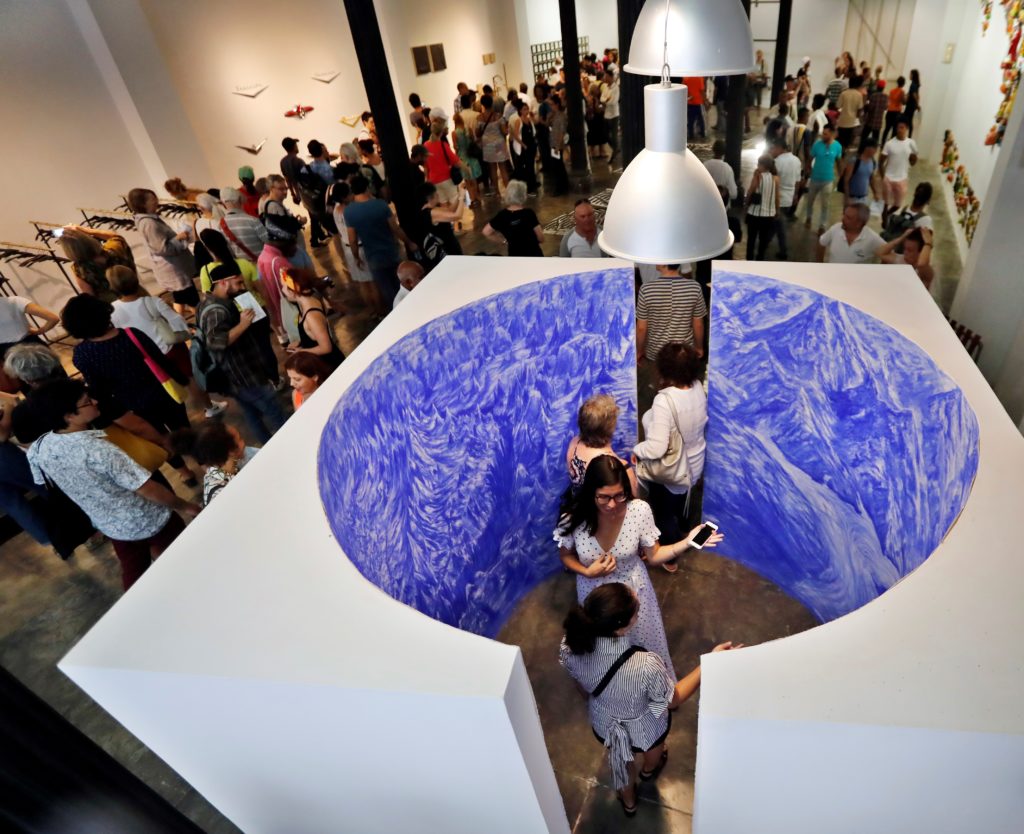[ad_1]
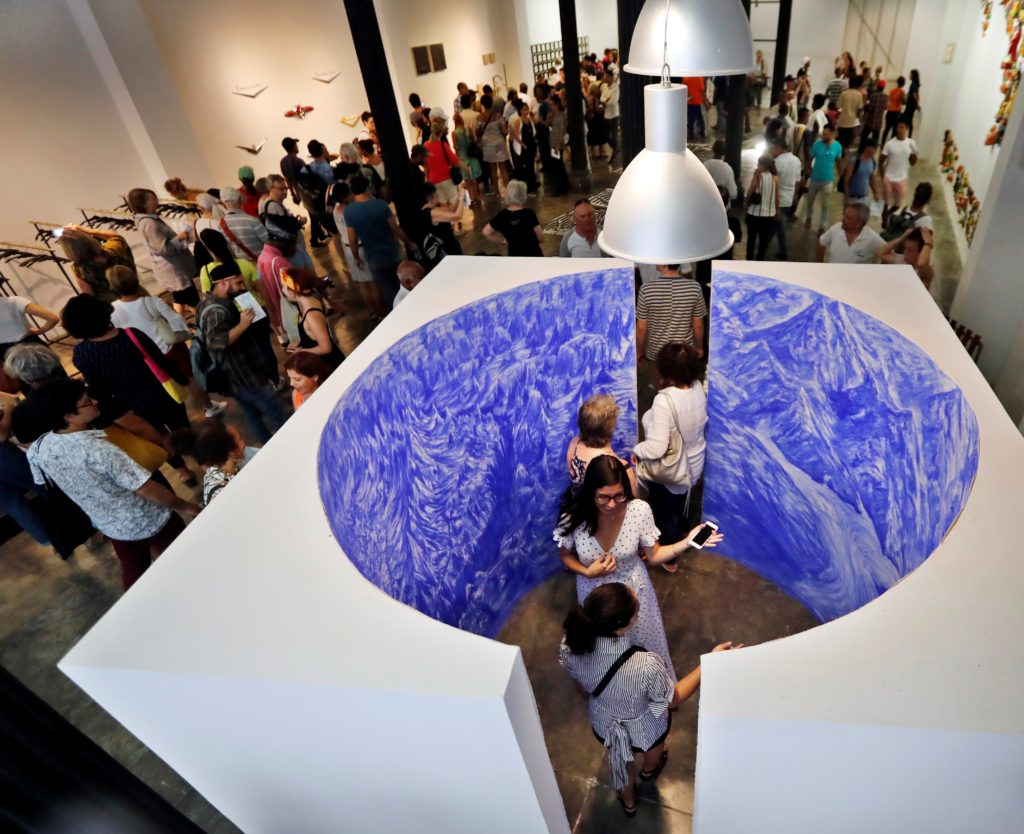
The opening of the Havana Biennial.
ERNESTO MASTRASCUSA/EPA-EFE/SHUTTERSTOCK
Two months before the opening of the 13th Havana Biennial, the tepidly received, three-hour telecast of the 2019 Grammy Awards featured an opening number by the young, charismatic Cuban-American pop star Camila Cabello. Singing her breakout hit, “Havana,” in a series of choreographed exchanges with fellow Latino luminaries Ricky Martin and venerated Cuban saxophonist Arturo Sandoval, Cabello shimmied her way through a two-story set reminiscent of her grandmother’s Havana home, where she grew up. With small, brightly colored rooms of partygoers mingling, the simulated house came to life to the sultry strains of “Havana,” the fiesta atmosphere spilling out into the “street”—the spot-lit stage of the Grammies.
This is the Havana of our dreams, an intimate city of romance, sizzling rhythms and rum-fueled parties late into the night. It’s the Havana glimpsed in the old black-and-white stills lining the corridors of the now shabby government-run hotel, portraying its once rich and infamous patrons; in the ornate colonial architecture, now crumbling because there has been little to no repair in over 50 years; in the cracked marble steps and rusted ironwork leading to a fancy restaurant or cocktail bar where history hangs like a sad ghost on the dilapidated décor and the signature mojitos must be avoided for the contaminated ice.
As always, or perhaps more than ever, the Cuban capital is a city of contradictions, with a vibrant culture eager to show itself to the world and an oppressive political climate that makes each day uncertain and self-expression a sometimes-punishable offense. With the national wage under $30 a month, ration books run out along with everyday supplies. Yesterday we had salt, but no toilet paper. Today cooking oil, but no milk. Whether doctor, lawyer, café owner, or cook, citizens go from shop to meager shop to hunt down essentials. Because amid the lofty slogans of the Castro revolution—Hasta la Victoria Siempre!—is a population perennially struggling, still hoping for a better tomorrow.
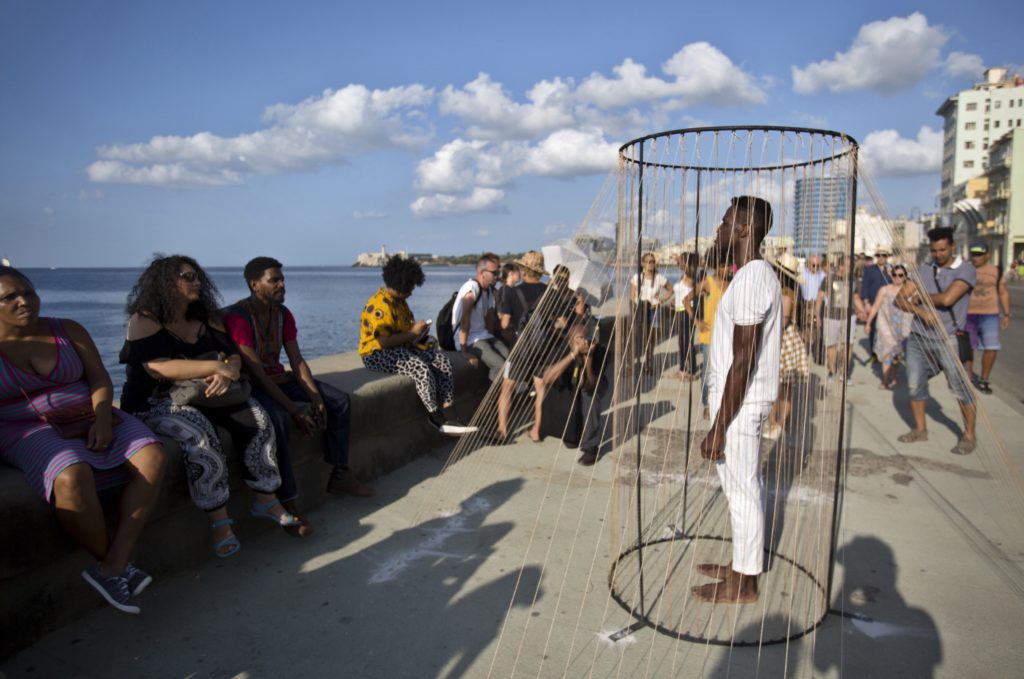
Carlos Martiel performing at the opening of the Havana Biennial.
YANDER ZAMORA/EPA-EFE/SHUTTERSTOCK
It is against this strife and symbolism that a committee of well-connected curators under the Ministry of Culture sought to create an event that in cities around the globe has become all but commonplace. “The Havana Biennale is being held in the midst of difficult circumstances,” curator Nelson Herrera Ysla wrote in the official catalog, a more-than-300-page compendium of all 83 artists hailing from 47 countries, including 17 from Cuba, invited to participate. (The United States is not included.) “Its history has been an endless struggle against all sorts of hardships, mostly financial, but also . . . ideological . . . and much more in the last years—the harassment of collectors, directors of trade fairs and museums, dealers, merchants and gallery owners . . . trying to earn money for their institutions.” Ysla’s essay, “The Multiple Constructions of the (Im)Possible,” is a play on this year’s theme, “The Construction of the Possible.” Officially a reference to the island-wide devastation of Hurricane Irma that preempted the biennial’s original timeline, the line is a covert lament of the many obstacles facing the arts community of Ysla’s Cuba.
Among them is a fresh piece of legislation in the Cuban Constitution updated in the wake of Raúl Castro’s stepping down from the presidency in 2018. Called Decree #349, it gives the state control of who can work as an artist and who cannot, making it illegal, for example, to mount an exhibit in an independent space without a government-issued license. Like many such rosters throughout the wrought history of compromised individual liberty in Cuba, the new “Registry of Creators” is an all but arbitrary, elite who’s who of those who pose the least threat to the government with their artistic content. Widely seen as a bureaucratic reaction to the un-sanctioned 00 Bienal staged last year within a small group of artists’ studios in Havana, hurricane damage notwithstanding, Decree #349 at its most draconian has seen the incarceration of the more outspoken artists against the regime. Notably among them is Tania Bruguera, the daughter of a Cuban minister and diplomat, who has made a career out of the polemical nature of contemporary art in Cuba.
Facing everything from drastic budget cuts to government censorship, Ysla concludes: “Those of us who have worked to preserve (the Biennale) against all odds sometimes thought it would be impossible.”
Yet while radical members of the local art contingent urged a boycott, with protestors donning “No al Decreto 349” T-shirts, a visitor to Havana today is easily unaware of all that has contributed to realizing this cultural milestone that has grown significantly since its inception in 1984. Reminiscent of the Venice blueprint of installations scattered throughout the city, what the month-long Havana Biennial lacks in pavilions dedicated to individual nations—besides Cuba—it makes up in group shows staged throughout the many cultural institutions, as well as myriad mini-exhibits and performances held in walk-in galleries and vacant lots, arcades and half-abandoned construction sites, dotting a main artery known as Calle Línea or elsewhere, along the wind-swept esplanades flanking the eight-kilometer sea wall (the Malecón), in a collective exhibit titled “Detras Del Muro” (“Behind the Wall”).
“It’s the city of Havana that is the work of art,” noted one curator, and while that may be so, it’s not necessarily a selling point, as the city is a ticking time bomb of critically endangered infrastructure with only the occasional bright note of scaffolding around some fragile edifices in Old Havana or a hotel complex being built, somewhat ominously, and sans consideration for aesthetics, by an anonymous foreign government.
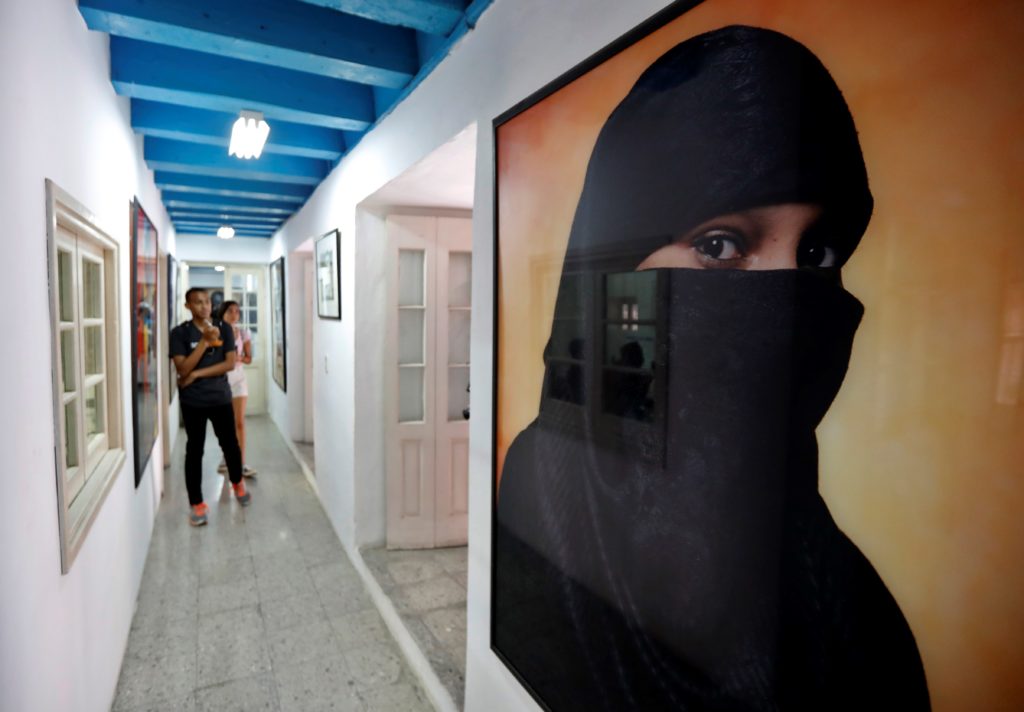
The opening of the Havana Biennial.
ERNESTO MASTRASCUSA/EPA-EFE/SHUTTERSTOCK
Among the more prestigious exhibits are housed in the de facto headquarters of the Biennial was the Wilfredo Lam Center for Contemporary Art, named for the eponymous artist considered the Cuban Picasso and anchoring a picturesque corner of Old Havana. Here were leading Cuban painter David Beltrán’s abstract compositions in ochre, purple, and soft aquatic hues from his series “Archeology of Color,” based on photo-magnified close-ups of pigment from well-known neoclassical works.
Speaking last year in the studio in Havana he shares with fellow “Registry” artist Glenda León, Beltrán seemed resolutely focused on the artistic process—on beauty over politics—perhaps one reason he is one of the more widely commissioned artists in Cuba and was a member of the closed circle at the Biennial opening in April. An adjacent gallery featured Abdoulayé Konaté, of Mali, whose wall-size collages of multicolored textile strips are a pertinent ode to diversity, and Tamara Campo, of Pinar del Rio, Cuba, whose interactive installation, Blanco, is a geometric maze of stark, floor to ceiling panels observers may pass through, hopefully finding a “shared space of peace and light.”
At the Museo Nacional de Bellas Artes, pieces from the permanent collection were recalibrated in a series of exhibits along the exalted themes of “Beyond Utopia,” “The Mirror of Enigmas: Notes on Cubaness,” and “Rereading History.” It should be noted that the museum, established in the mid-1950s, has not shied from showing controversial work in its effort to represent a comprehensive history Cuban art from its colonial beginnings to 2000. One example is Antonia Eiriz’s 1968 masterpiece Una Tribuna para la Paz Democratica (A Tribune for Democratic Peace), which depicts blank faces in a crowd before a dictator’s podium. Condemned by the government, Eiriz ceased painting altogether in quiet protest. And here is the artist known as Kcho’s 1993 installation La Regata, a flotilla of miniature makeshift boats, many made from debris one still sees on the streets of Havana, evoking the mass migration from Cuba in that period of unrest. Silence—represented by disfigured mouths, isolation—in so many images of an island cut off from world progress—these poignant motifs of personal and societal turmoil persist in Cuban art to this day.
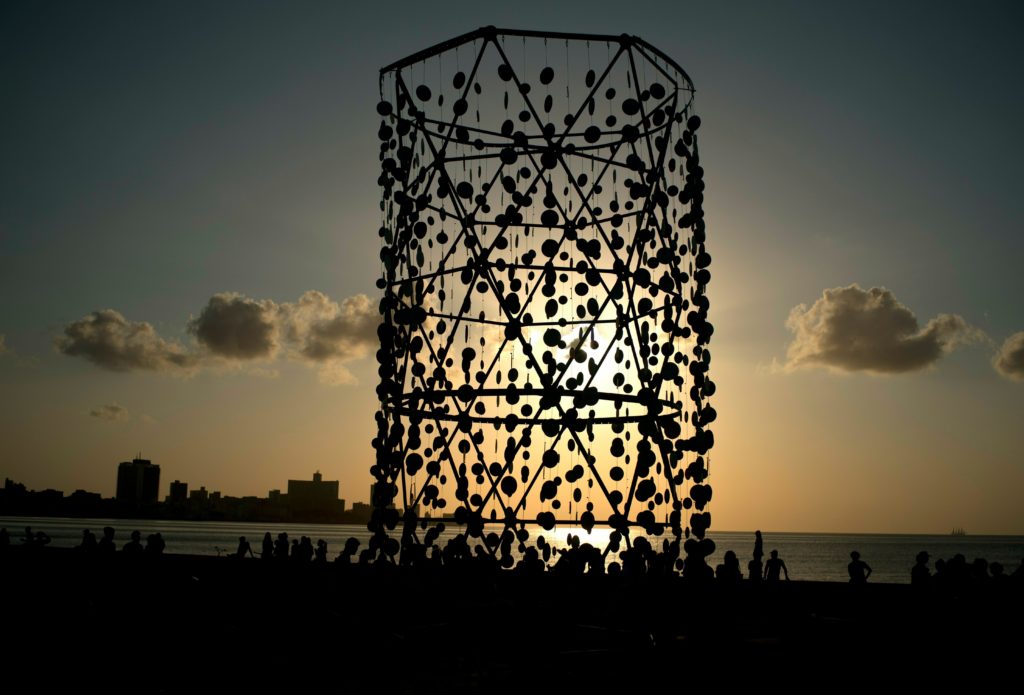
The scene at the Havana Biennial.
RAMON ESPINOSA/AP/SHUTTERSTOCK
“All art in Cuba is political,” said Mayret González, the Cuban-born founder ARTempoCuba, a U.S.-based nonprofit that seeks to help Cuban artists participate in an art market that eludes them in their native country. By launching her guide book Cutting Edge Art in Havana on opening weekend of the biennial, González sought to highlight the event’s venue, indie art space Arsenal Habana, which featured a “futuristic” group show “Be Realistic. Demand the Impossible.” One of a handful of alternative art spaces across the city, Arsenal’s fate is at risk under Decree #349. “Cuban government officials in charge of the country’s cultural policy have kept watch over the domestic exhibition of Cuban contemporary art in their zeal to thwart any discourse or practice that might challenge the official line.” The phrase is from González’s capsule history of the state of art in Cuba in the ‘90s, but it is just as relevant today.
Will this self-professed “Biennale for history,” so hard-fought by relatively few, fulfill its mission of “Rethinking the Future” while fervently looking to the past as part of the 500th anniversary of Habana?
In a sleek, European-style bar on a polluted and pocked thoroughfare in El Vedado, a bouncer at the door lets in certain people and not others. Tourists are welcome, as are well-heeled Cubans and their families. A TV screen above the bar playing MTV-style videos on loop presents a demure Cabello in a plush, sophisticated interior, sexily slinking among impeccably-dressed figures as she purrs the melodies of “Havana.”
No one is looking. No one is listening. This is not their Havana.
The Havana Biennial ran from April 12 through May 12.
[ad_2]
Source link

